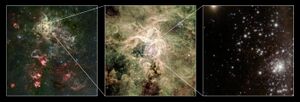Astronomy:R136c
| Observation data Equinox J2000.0]] (ICRS) | |
|---|---|
| Constellation | Dorado |
| Right ascension | 5h 38m 42.90s[1] |
| Declination | −69° 06′ 04.83″[1] |
| Apparent magnitude (V) | 12.86[1] |
| Characteristics | |
| Evolutionary stage | Wolf–Rayet star |
| Astrometry | |
| Distance | 163,000 ly (49,970[2] pc) |
| Absolute magnitude (MV) | −7.9[1] |
| Details[3] | |
| Mass | 142 M☉ |
| Radius | 40.7 R☉ |
| Luminosity | 3,800,000 L☉ |
| Temperature | 42,170 K |
| Rotational velocity (v sin i) | <200 km/s |
| Age | 1.8 Myr |
| Other designations | |
BAT99 112, RMC 136c, VFTS 1025[3] | |
| Database references | |
| SIMBAD | data |
R136c is a star located in R136, a tight knot of stars at the centre of NGC 2070, an open cluster weighing 450,000 solar masses and containing 10,000 stars.[4] At 142 M☉ and 3.8 million L☉, it is the one of the most massive stars known and one of the most luminous, along with being one of the hottest, at over 40,000 K. It was first resolved and named by Feitzinger in 1980, along with R136a and R136b.[5]
Description
R136c is a Wolf–Rayet star of the spectral type WN5h and with a temperature of 42,170 K, making it one of hottest stars known. It is the one of the most massive stars known, with a mass of 142 M☉, and it is one of the most luminous stars known, with a luminosity of 3.8 million L☉. The extreme luminosity is produced by the CNO fusion process in its highly compressed hot core. Typical of all Wolf–Rayet stars, R136c has been losing mass by means of a strong stellar wind with speeds over 2,000 km/s and mass loss rates in excess of 10−5 solar masses per year.[6] It is strongly suspected to be a binary, due to the detection of hard x-ray emission typical of colliding wind binaries, but the companion is thought to make only a small contribution to the total luminosity.[7]
Evolution
R136c is so energetic that it has already lost a substantial fraction of its initial mass, even though it is only a few million years old. It is still effectively on the main sequence, fusing hydrogen at its core via the CNO cycle, but it has convected and mixed fusion products to the surface and these create a powerful stellar wind and emission spectrum normally only seen in highly evolved stars.[6]
Its fate depends on the amount of mass it loses before its core collapses, but is likely to result in a supernova. The most recent models for single star evolution at near-solar metallicities suggest that the most massive stars explode as highly stripped type Ic supernovae, although different outcomes are possible for binaries. Some of these supernovae are expected to produce a type of gamma-ray burst and the expected remnant is a black hole.[8]
References
- ↑ 1.0 1.1 1.2 1.3 Doran, E. I.; Crowther, P. A.; de Koter, A.; Evans, C. J.; McEvoy, C.; Walborn, N. R.; Bastian, N.; Bestenlehner, J. M. et al. (2013). "The VLT-FLAMES Tarantula Survey - XI. A census of the hot luminous stars and their feedback in 30 Doradus". Astronomy & Astrophysics 558: A134. doi:10.1051/0004-6361/201321824. Bibcode: 2013A&A...558A.134D.
- ↑ Pietrzyński, G et al. (7 March 2013). "An eclipsing-binary distance to the Large Magellanic Cloud accurate to two per cent". Nature 495 (7439): 76–79. doi:10.1038/nature11878. PMID 23467166. Bibcode: 2013Natur.495...76P.
- ↑ 3.0 3.1 Schneider, F. R. N.; Sana, H.; Evans, C. J.; Bestenlehner, J. M.; Castro, N.; Fossati, L.; Gräfener, G.; Langer, N. et al. (2018). "An excess of massive stars in the local 30 Doradus starburst". Science 359 (6371): 69–71. doi:10.1126/science.aan0106. PMID 29302009. Bibcode: 2018Sci...359...69S.
- ↑ Bosch, Guillermo; Terlevich, Elena; Terlevich, Roberto (2009). "Gemini/GMOS Search for Massive Binaries in the Ionizing Cluster of 30 Dor". Astronomical Journal 137 (2): 3437–3441. doi:10.1088/0004-6256/137/2/3437. Bibcode: 2009AJ....137.3437B.
- ↑ Feitzinger, J. V.; Schlosser, W.; Schmidt-Kaler, T.; Winkler, C. (1980). "The central object R 136 in the gas nebula 30 Doradus - Structure, color, mass and excitation parameter". Astronomy and Astrophysics 84 (1–2): 50. Bibcode: 1980A&A....84...50F.
- ↑ 6.0 6.1 Crowther, P. A.; Schnurr, O.; Hirschi, R.; Yusof, N.; Parker, R. J.; Goodwin, S. P.; Kassim, H. A. (2010). "The R136 star cluster hosts several stars whose individual masses greatly exceed the accepted 150 M⊙ stellar mass limit". Monthly Notices of the Royal Astronomical Society 408 (2): 731. doi:10.1111/j.1365-2966.2010.17167.x. Bibcode: 2010MNRAS.408..731C.
- ↑ Hainich, R.; Rühling, U.; Todt, H.; Oskinova, L. M.; Liermann, A.; Gräfener, G.; Foellmi, C.; Schnurr, O. et al. (2014). "The Wolf-Rayet stars in the Large Magellanic Cloud". Astronomy & Astrophysics 565: A27. doi:10.1051/0004-6361/201322696. Bibcode: 2014A&A...565A..27H.
- ↑ Groh, J. H.; Meynet, G.; Georgy, C.; Ekström, S. (2013). "Fundamental properties of core-collapse supernova and GRB progenitors: Predicting the look of massive stars before death". Astronomy & Astrophysics 558: A131. doi:10.1051/0004-6361/201321906. Bibcode: 2013A&A...558A.131G.
 |


